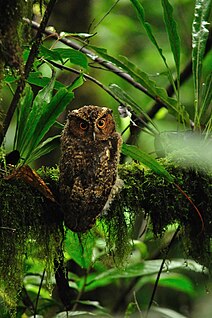
Scops owls are typical owls in family Strigidae belonging to the genus Otus and are restricted to the Old World. Otus is the largest genus of owls with 57 species. Scops owls are colored in various brownish hues, sometimes with a lighter underside and/or face, which helps to camouflage them against the bark of trees. Some are polymorphic, occurring in a greyish- and a reddish-brown morph. They are small and agile, with both sexes being compact in size and shape. Female scops owls are usually larger than males.

The Philippine scops owl is a common owl, endemic to the Philippines, belonging to the family of the typical owls Strigidae. Other common names include "Otus Whitehead", "Whitehead scops owl" and "Luzon lowland scops owl". Everett's scops owl and Negros scops owls were formerly considered conspecific but are now classified as subspecies of Otus megalotis.

The Serendib scops owl is the most recently discovered bird of Sri Lanka. It was originally located by its unfamiliar poo-ooo call in the Kitulgala rainforest by prominent Sri Lankan ornithologist Deepal Warakagoda. Six years later, it was finally seen by him on 23 January 2001 in Sinharaja, and formally described as a species new to science in 2004. Apart from Sinharaja and Kitulgala, it has also been found at Runakanda Reserve in Morapitiya and Eratna Gilimale. Known as පඩුවන් බස්සා in Sinhala.
The Karthala scops owl, also known as the Grand Comoro scops owl or Comoro scops owl, is a small, scops owl endemic to the island of Grande Comore in the Comoro Islands.
The Moheli scops owl is a scops owl endemic to the island of Mohéli, one of the Comoro Islands.
The Anjouan scops owl is an owl endemic to the island of Anjouan in the Comoro Islands.

The Siau scops owl is a critically endangered owl species, which may even be extinct. They live on Siau Island, north of Sulawesi, Indonesia and are (were) forest dwellers. The species is only known from a single holotype from 1866 although there have been some local reports in recent years. Even so, their habitat is being lost to excessive logging of the forest on the island and there would be very few if any individuals left. The taxonomic arrangement for this owl has not been fully worked out. While recognized as a distinct species by the IOC, others consider it as a subspecies of either the Sulawesi scops owl or Moluccan scops owl.

The sandy scops owl, or cinnamon scops owl, is an owl from the family Strigidae found in Africa.

The Sokoke scops owl is a highly localized species of scops owl found in lowland forests of Kenya and Tanzania. The greatest population of this species of owl is in the Cynometra-Manilkara forest, which is less than one-third of the Sokoke Forest. It is also found in the Afzelia-Cynometra forest.

The Flores scops owl is an owl endemic to the island of Flores, Indonesia. It is threatened by habitat loss. This owl is around 19–21 cm from head to tail. They are a forest dwelling owl that is smallish in size. Some 250–2,499 individuals are estimated to be extant in the wild, dwindling due to habitat loss.

The Rajah scops owl is a species of owl found on the islands of Borneo and Sumatra. The bird is named after James Brooke, Rajah of Sarawak. Based on patterns of speciation in other endemic montane bird species of the same region, it may potentially have to be split into two distinct species; if so, the name Otus brooki would be restricted to just the Bornean population.

The Sunda scops owl is a small brown owl native to the Sunda Islands.

The Palawan scops owl is an owl endemic to Philippines only being found in the island of Palawan. It is found on tropical moist lowland forest. It is threatened by habitat loss.
The Ryūkyū scops-owl or elegant scops-owl is a small rufous-brown owl with a brown face disk and a cinnamon facial ruff. The bill is olive-grey and it has yellow eyes.

The Sulawesi scops owl is an owl found on the Sulawesi island of Indonesia.

The Biak scops owl is a species of owl endemic to the twin islands of Biak-Supiori in Cenderawasih Bay, Papua, Indonesia.

The giant scops owl, lesser eagle-owl or the Mindanao eagle-owl, is a species of owl in the family Strigidae. It is endemic to the Philippines. In size and structure, it is considered intermediate between a scops owl and an eagle-owl. Its natural habitat is subtropical or tropical moist lowland forests. It is threatened by habitat loss.

The Pemba scops owl is a species of owl in the family Strigidae. It is endemic to Pemba Island which is part of and off the coast of Tanzania.

The Dulit frogmouth is a little-known species of bird in the frogmouth family, Podargidae, with a patchily recorded distribution in the mountain forests of northern and central Borneo to which it is endemic. The species is monotypic.

















